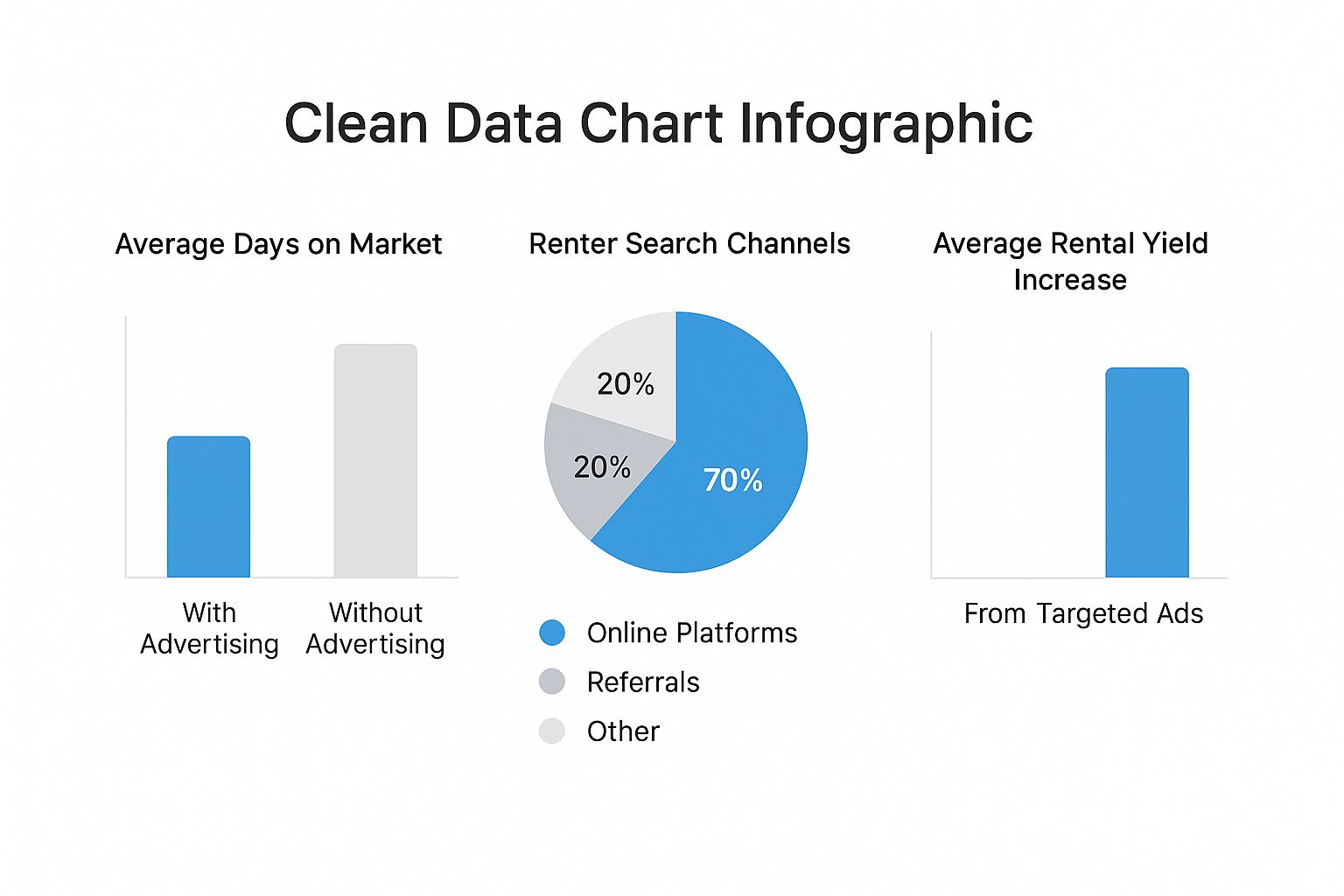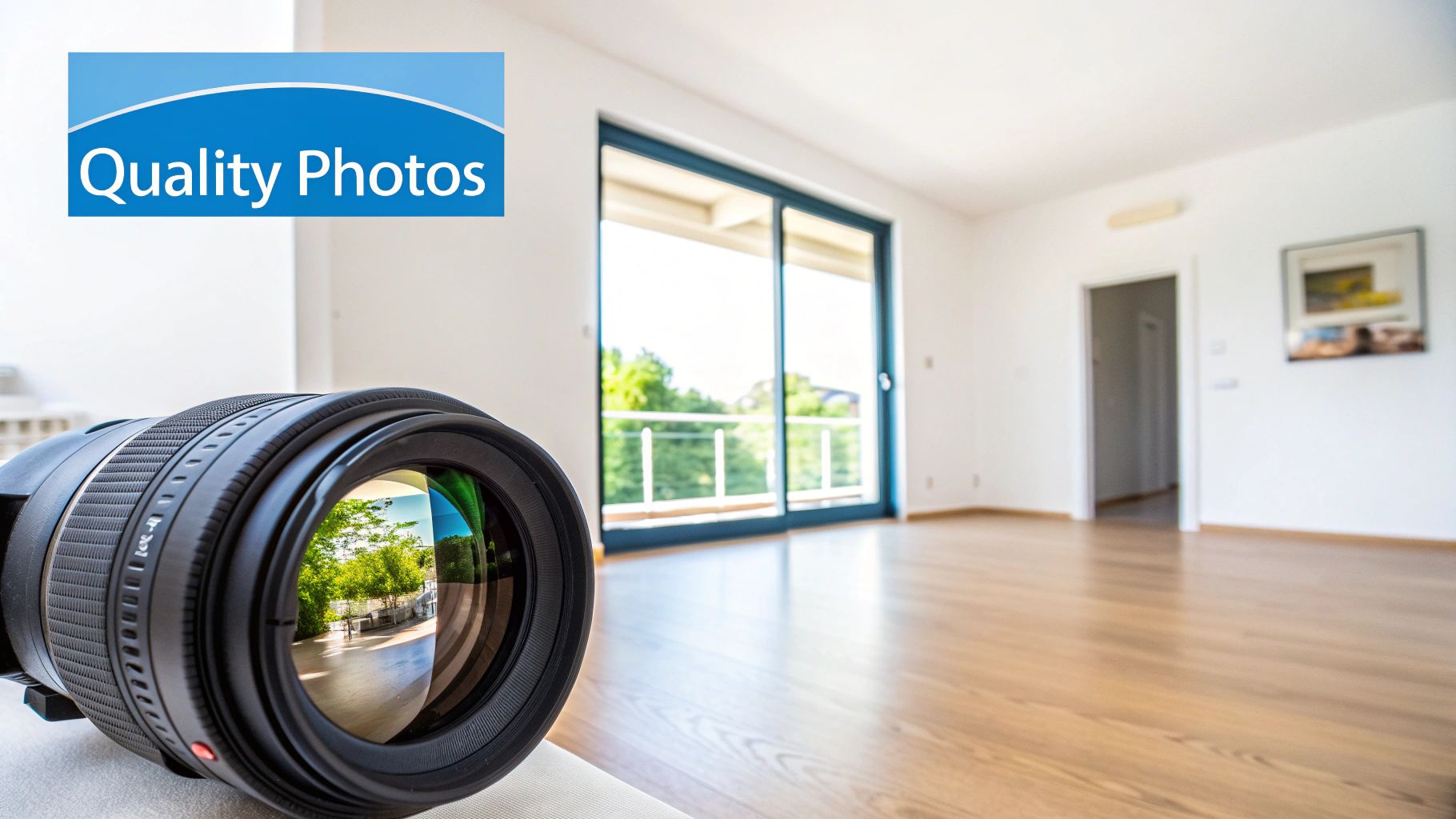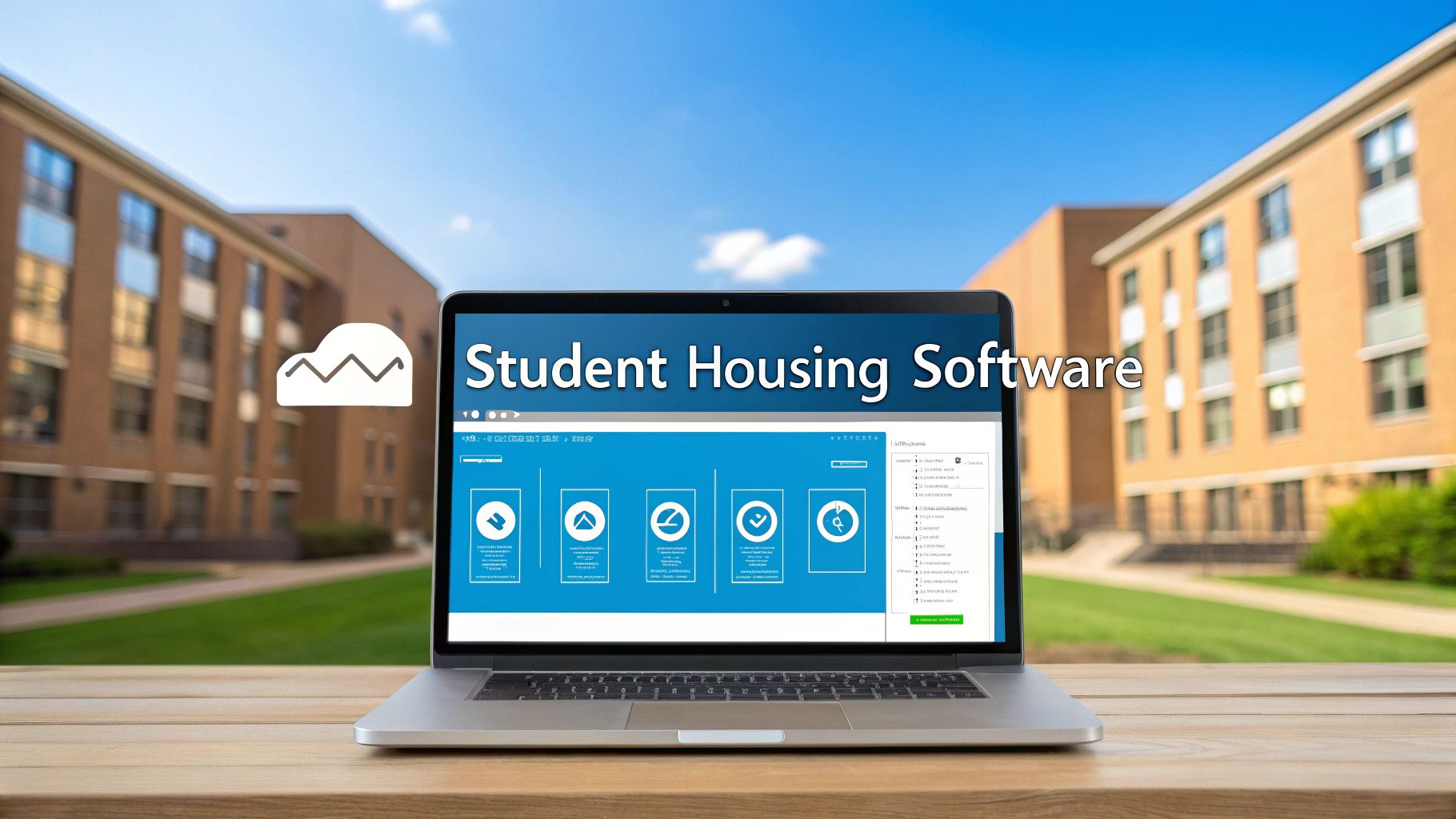For large-scale property management companies, "advertising" isn't a one-off task—it's an operational system. When you manage a portfolio of hundreds or thousands of units, a repeatable framework isn't just a nice-to-have; it's the only way to minimize vacancy costs and maintain profitability. The goal is to move beyond simply posting a listing and hoping for the best. Random acts of marketing lead to inconsistent results and bloated Days on Market (DOM). A scalable framework, on the other hand, gives you a standardized process to accelerate your speed-to-lease across every market.
This all starts by tracking the metrics that directly impact revenue. Forget vanity metrics like impressions; your operations team needs to be obsessed with the Key Performance Indicators (KPIs) that drive financial performance.
Core Advertising KPIs for Enterprise Portfolios
- Cost Per Lease (CPL): This is your north-star metric for acquisition efficiency. It calculates the total marketing and leasing spend required to secure one signed lease, providing a clear measure of your advertising ROI.
- Lead-to-Tour Conversion Rate: This KPI shines a light on the efficiency of your initial response and scheduling process. A low conversion rate is a critical red flag, often pointing to a process bottleneck that adds unnecessary days to your vacancy time and directly impacts revenue.
- Days on Market (DOM): Every single day a unit sits empty represents lost revenue. For a portfolio of 1,000 units, even a one-day reduction in average DOM can translate into hundreds of thousands of dollars in recovered annual revenue. Tracking DOM by property type and market helps you spot outliers and diagnose advertising inefficiencies.
By setting data-backed benchmarks for these KPIs, you start building a system for continuous improvement. You're no longer just running disconnected ad campaigns—you're building a predictable leasing engine that scales.
This infographic breaks down just how much a structured approach impacts everything from vacancy rates to renter behavior and overall rental yield.

The numbers don't lie. A strategic investment in your advertising process drastically cuts down how long your properties sit empty and brings in better financial returns by attracting qualified tenants faster.
Core Components of a High-Performance Rental Ad Strategy
Building a scalable advertising machine requires a few key pillars working in tandem. This table summarizes the core components that drive a successful campaign, turning ad spend into signed leases at an enterprise level.
Ultimately, each of these components feeds into the next, creating a predictable system that minimizes vacancy and maximizes revenue across your entire portfolio.
Creating Visuals That Dominate Online Listings
In a market where renters swipe through dozens of listings in minutes, your property's photos are the single most important factor in capturing initial interest. For large portfolios, high-quality, professional photography isn't an expense; it's a direct investment in reducing Days on Market (DOM).
When managing a dispersed portfolio, "just taking good photos" isn't a scalable plan. You need a rock-solid, standardized process that guarantees every single property, regardless of location, is presented professionally online. This starts with a mandatory shot list.
Standardize Your Visual Assets
Creating a standardized shot list ensures that whether you're using an in-house team or a network of freelance photographers, the final product is always consistent and high-quality. It eliminates guesswork and ensures every listing highlights the features that drive tour requests.
Here’s what your standard shot list should cover:
- Exterior: At least 2-3 shots of the front of the property, capturing the entryway and curb appeal.
- Main Living Areas: 3-5 wide-angle shots of the living and dining spaces from different perspectives to show the layout and flow.
- Kitchen: 3-4 detailed photos focusing on countertops, appliances, and cabinet space.
- Bedrooms & Bathrooms: 2 shots per room, including one of the closet space—a critical selling point for many renters.
- Amenities: Professional photos of any shared amenities like pools, gyms, or common areas.
This level of detail has a direct impact on lead quality and speed-to-lease. According to Zillow, properties showcased with professional photography lease 32% faster on average. With nearly all renters (99%) citing photos as the most critical factor in their search, cutting corners here is not an option.
Consider the revenue impact. For a portfolio of 1,000 units, if professional photos slash just five days off the average DOM for properties renting at $2,000/month, you’ve just recovered over $330,000 in potential vacancy loss annually. That more than justifies the investment in a scalable visual asset strategy.
But don't stop at static images. Adding 3D tours and video walk-throughs can significantly accelerate the leasing cycle. These tools pre-qualify leads by offering a comprehensive virtual viewing, meaning prospects who book in-person or self-guided tours are already highly interested.
Take a look at our guide on the impact of high-quality marketing photos to learn how to build a visual strategy that scales. This is how you turn a simple online listing into a powerful conversion tool.
Choosing the Right Advertising Channels for Your Portfolio

Where you advertise your rental properties is just as important as the ad content itself. For large portfolios, a "post and pray" strategy on a single site is a surefire way to watch your Days on Market (DOM) climb. A data-driven, multi-channel approach is necessary to reach the widest pool of qualified tenants efficiently.
The real estate ad market is projected to exceed USD 56.5 billion by 2032, driven by the fact that over 60% of renters begin their search online. This massive digital shift demands an advertising strategy rooted in data, not outdated habits.
Optimizing Your Channel Mix at Scale
When you're overseeing hundreds—or thousands—of units, manual listing posting is an operational nightmare and a source of costly errors. This is where listing syndication becomes an essential component of your property management technology stack.
By integrating your Property Management Software (PMS) with major listing sites via an API, you create a single source of truth. Update a price, swap a photo, or tweak a description in your PMS, and it instantly populates across every platform.
This is about more than just efficiency. At scale, syndication is a critical quality control tool. It prevents data entry errors—like an incorrect rent price or outdated availability—that can kill lead flow and add weeks to your vacancy time. An integrated system like Showdigs can pull listing data directly from your PMS, ensuring every ad is accurate from the moment it goes live.
The goal is to automate repetitive tasks so your leasing team can focus on high-value activities like lead follow-up and closing deals. Your channel mix should be a blend of major platforms and niche sites, tailored to the specific markets you operate in.
- Major Listing Sites (Zillow, Apartments.com): These are non-negotiable for achieving broad exposure and attracting a high volume of leads.
- Social Media (Facebook Marketplace): A powerful tool for reaching local renters and generating organic leads, especially for single-family homes or smaller multifamily properties without onsite staff.
- Niche Sites: Depending on your portfolio, targeted sites for specific audiences (e.g., corporate housing, student rentals, pet-friendly communities) can deliver highly qualified leads with higher conversion rates.
By automating your listing distribution, you ensure maximum visibility with minimal manual effort. You can learn more about streamlining this whole process in our guide to marketing your listings effectively.
Crafting Ad Copy That Converts Clicks Into Tours

Once your professional photos capture a prospect's attention, your ad copy must convert that interest into a tour. For large portfolios, inconsistent or poorly written ad copy is a silent killer of your bottom line, leading to unqualified leads, wasted agent time, and longer vacancy cycles. The objective is to create compelling, compliant, and—most importantly—scalable ad copy.
This starts with a powerful, data-rich headline that filters and qualifies prospects immediately.
A strong headline provides the core information renters need to self-qualify. It eliminates anyone for whom the price, size, or move-in date is a dealbreaker before they even click, improving the quality of your inbound leads.
Example Headline: $2,100 - 3 Bed/2 Bath Modern Townhome | Private Patio, W/D | Available June 1
From Features to Benefits
The body of your ad must do more than list amenities. Prospects aren't just looking for features; they're envisioning a better lifestyle in your property. This mindset shift is critical for advertising rental properties effectively at scale.
Translate the "what" into the "why it matters."
Instead of: "Granite countertops and stainless steel appliances."
Try: "Entertain friends in a modern chef's kitchen featuring sleek granite countertops and new stainless steel appliances."
Instead of: "Large backyard."
Try: "Enjoy summer evenings in your spacious, private backyard, perfect for barbecues and outdoor relaxation."
This benefit-driven approach creates an emotional connection that a simple feature list cannot. If you want to dive deeper into this, there are some great tips for writing killer ad copy that can help.
Ensuring Compliance and Consistency
For any property manager overseeing a large, multi-market portfolio, maintaining Fair Housing Act compliance is non-negotiable. Standardized copy templates are your most effective tool for risk mitigation.
Using templates ensures brand consistency across all listings and eliminates the risk of discriminatory language. They also make your team more efficient, allowing you to get new listings live in a fraction of the time.
Your call-to-action (CTA) must be equally sharp. Ditch the vague "Contact us for details." Be direct and drive immediate action: "Tours available 7 days a week. Click here to schedule your self-guided tour instantly!" This clarity is what directly boosts your lead-to-tour conversion rate and reduces speed-to-lease.
Measuring Performance and Optimizing to Lower DOM

You can't improve what you don't measure. Systematically reducing Days on Market (DOM) across a large portfolio requires a data-driven feedback loop, not guesswork.
This means looking past vanity metrics like page views and digging into the data that directly impacts your bottom line. Effective rental advertising is about tracking the entire leasing funnel, from initial click to signed lease. The goal is to pinpoint the bottlenecks that are inflating your vacancy costs and reallocate ad spend toward what is proven to work.
Key Metrics for Portfolio Optimization
For operations directors and portfolio managers, a few key data points reveal the health of your entire lead-to-lease pipeline.
- Lead-to-Tour Conversion Rate: This metric immediately exposes friction in your scheduling process. A low conversion rate is a critical red flag, often indicating slow response times or a clunky user experience that’s costing you qualified leads and revenue.
- Cost Per Application: This metric helps you differentiate serious prospects from casual browsers, showing which advertising channels deliver applicants who are ready to commit.
- Cost Per Lease (CPL): This is the ultimate measure of your advertising ROI. By tracking CPL by channel, you can confidently optimize your marketing budget, doubling down on what works and cutting inefficient spend.
By obsessing over these metrics, you shift from a reactive to a proactive leasing strategy. You can spot underperforming properties or markets before they become a major revenue drain and make nimble adjustments to your advertising mix.
Creating a Data-Driven Feedback Loop
Continuously refining your approach is critical, especially as competition in the rental market intensifies. With the recent surge in multifamily unit supply, optimized advertising is more important than ever.
Run simple A/B tests to compare different ad elements. Analyze the performance of different headlines, lead photos, or calls-to-action on your listings. Small tweaks can lead to a significant lift in engagement. For example, does a headline promoting "Instant, Self-Guided Tours Available" outperform one highlighting a specific amenity? The data will provide the answer.
To truly move the needle on your DOM and convert more inquiries into tours, apply proven conversion rate optimization tips to your rental listings. This data-first mindset transforms advertising from a necessary expense into a powerful tool for revenue growth.
And for a deeper dive into speeding up your entire leasing cycle, check out these seven actionable ways to lease properties quicker and cheaper.
Frequently Asked Questions from Large-Scale Operators
We work with property managers running large-scale operations every day. Here are a few common questions, with straightforward advice for optimizing your advertising and minimizing vacancy rates across your portfolio.
How Much Should We Budget for Advertising?
For large portfolios, move away from flat-fee thinking and focus on cost per lease (CPL).
A common benchmark is to budget 50-100% of one month's rent to cover all turnover costs, including marketing and commissions. The key is to meticulously track ad spend and lead sources for each channel to understand your true ROI. Once you know which channels deliver high-converting leads at the lowest CPL, you can optimize your spend. For a portfolio managing over 1,000 units, even a 5% improvement in CPL translates into massive annual savings.
What's the Single Biggest Advertising Mistake to Avoid?
Without a doubt, the most common and costly mistake is using low-quality photos. Dark, blurry, or unprofessional images are a direct path to fewer clicks, lower-quality leads, and extended vacancy periods. In today's digital market, professional visuals are non-negotiable.
Investing in a scalable system for professional photos across your entire portfolio isn't a luxury; it's a core operational function that will slash your Days on Market (DOM) and deliver a significant return on investment. Bad photography directly harms your lead-to-tour conversion rate.
Treat professional visuals as a requirement, not an optional expense.
How Often Should a Stale Rental Ad Be Refreshed?
If a property has been on the market for more than 14 days, it's time for a systematic review. Don't just repost it; dig into the data.
- High views, low leads? The issue is likely price or photos. One of them is deterring prospects.
- Low views, low leads? Your headline is failing to capture attention, or you're advertising on the wrong channels for that specific unit.
For large portfolios, the best practice is to use automated alerts. Configure your system to flag any property that exceeds your average DOM. This trigger should initiate a standardized review of its advertising performance, enabling your team to make immediate, data-backed adjustments.
Ready to slash your Days on Market and automate your entire leasing process from lead to lease? Showdigs combines AI-powered scheduling software with a nationwide, on-demand network of licensed agents to get your properties shown faster. Book a demo today and see how you can cut vacancy costs and scale your operations with unmatched efficiency.







